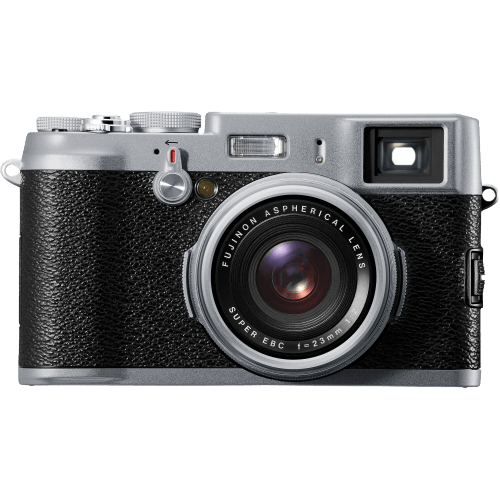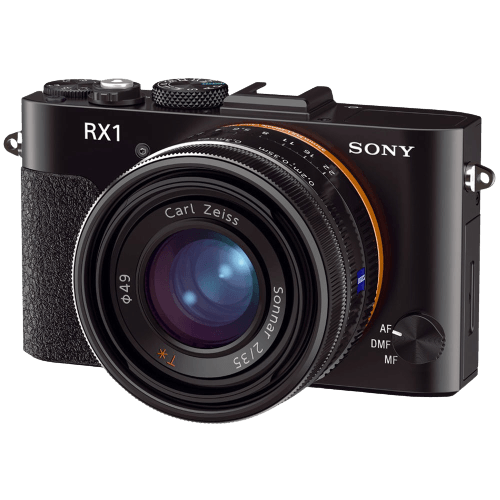Fujifilm FinePix X100 vs Sony Cyber-shot DSC-RX1 Comparison
Fujifilm FinePix X100

Sony Cyber-shot DSC-RX1

The Sony Cyber-shot DSC-RX1 takes the lead with a score of 57/100, while the Fujifilm FinePix X100 trails behind at 42/100. Both cameras share the same compact classification and have similar announcement dates, with the X100 in 2010 and the RX1 in 2012. The RX1 outperforms the X100 with a higher score, which can be attributed to its better specifications.
The RX1 is more expensive, with a launch price of $2800 compared to the X100’s $999. However, it is also smaller and lighter, measuring 113 x 65 x 70mm and weighing 482g, while the X100 measures 126 x 75 x 54mm and weighs 445g. This makes the RX1 more portable and convenient for on-the-go photography.
Although the X100 has a lower score, it is still a decent camera with a more affordable price tag. This makes it a suitable option for those looking for a compact camera on a tighter budget.
Taking all factors into account, the Sony Cyber-shot DSC-RX1 emerges as the better camera due to its higher score, compact size, and lighter weight. However, the Fujifilm FinePix X100 may be a more budget-friendly choice for some photographers.
Fujifilm FinePix X100 vs Sony Cyber-shot DSC-RX1 Overview and Optics
The Sony Cyber-shot DSC-RX1 outperforms the Fujifilm FinePix X100 in terms of optics, with a score of 67/100 compared to the X100’s 48/100. Both cameras share some common specifications, including a CMOS sensor, 5 FPS shooting speed, and fixed lens mounts, meaning neither camera allows for interchangeable lenses. Additionally, both cameras lack image stabilization.
The Sony RX1’s superiority in optics can be attributed to its higher megapixel count (24.3 MP versus the X100’s 12.3 MP), which allows for greater detail and resolution in captured images. Furthermore, the RX1 boasts a full-frame sensor, which is larger than the X100’s APS-C sensor. This larger sensor size enables the RX1 to capture more light and produce better image quality, especially in low-light conditions. The RX1’s sensor also has a DXOMARK score of 93, which is a reliable indicator of its high image quality. Unfortunately, DXOMARK does not score Fujifilm cameras, so a direct comparison is not possible.
Although the Fujifilm X100 falls behind the Sony RX1 in terms of optics, it does have one advantage: its EXR processor. The EXR processor is known for its ability to optimize image quality and noise reduction in various lighting conditions, giving the X100 an edge in certain scenarios.
Taking into consideration the aforementioned points, the Sony Cyber-shot DSC-RX1 is the clear winner in terms of optics, thanks to its higher megapixel count, full-frame sensor, and impressive DXOMARK score. However, the Fujifilm FinePix X100 does hold its own with its EXR processor, which can optimize image quality in specific situations.
Fujifilm FinePix X100 vs Sony Cyber-shot DSC-RX1 Video Performance
The Sony Cyber-shot DSC-RX1 outperforms the Fujifilm FinePix X100 in video capabilities, with a video score of 56/100 compared to the X100’s 34/100. This 22-point difference highlights the superior video performance of the RX1.
Both cameras lack time-lapse functionality built-in, which means neither has an advantage in this aspect. However, the similarities end there, as the RX1 has a clear edge in other video specifications. The RX1 offers Full HD video resolution, with maximum dimensions of 1920 x 1080, while the X100 only reaches Standard HD and max video dimensions of 1280 x 720. This means the RX1 produces higher quality, more detailed videos. Additionally, the RX1 has a max video frame rate of 60fps, double the X100’s 24fps. This allows for smoother motion and better slow-motion capabilities in the RX1’s videos.
The X100 does not have any advantages over the RX1 in terms of video capabilities. The lower video score and specifications make it clear that the RX1 is the superior choice for those looking for better video performance in their camera.
Taking into account the significant differences in video scores and specifications, it is evident that the Sony Cyber-shot DSC-RX1 is the better camera for video capabilities. The Full HD resolution, larger video dimensions, and higher frame rate make the RX1 a more suitable option for capturing high-quality videos. On the other hand, the Fujifilm FinePix X100 falls short in this category and should not be the primary choice for those who prioritize video performance.
Fujifilm FinePix X100 vs Sony Cyber-shot DSC-RX1 Features and Benefits
The Sony Cyber-shot DSC-RX1 emerges as the winner in terms of features, with a score of 44/100, compared to the Fujifilm FinePix X100’s score of 34/100. Both cameras share some common specifications, such as a lack of touchscreen, GPS, WIFI, and Bluetooth. However, the Sony RX1 surpasses the Fujifilm X100 in other aspects, making it the superior choice in this comparison.
The Sony RX1 has a larger screen size of 3 inches, while the Fujifilm X100 has a smaller 2.8-inch screen. The screen resolution of the Sony RX1 is also significantly higher at 1,229,000 dots, compared to the Fujifilm X100’s 460,000 dots. This means that the Sony RX1 provides a clearer and more detailed display for better image preview and camera control. Additionally, the Sony RX1 has a flip screen, which offers more flexibility and convenience in capturing images from various angles. The Fujifilm X100 lacks this feature.
On the other hand, the Fujifilm X100 does not have any significant advantages over the Sony RX1 in terms of features. The lower score of 34/100 reflects this fact, as it does not offer any unique or superior features compared to the Sony RX1.
Taking all these points into account, it is evident that the Sony Cyber-shot DSC-RX1 is the better choice due to its larger screen size, higher screen resolution, and flip screen feature. The Fujifilm FinePix X100, although not a bad choice, does not offer any advantages over the Sony RX1 in this comparison.
Fujifilm FinePix X100 vs Sony Cyber-shot DSC-RX1 Storage and Battery
The Fujifilm FinePix X100 and Sony Cyber-shot DSC-RX1 both score 16/100 in the storage and battery category. They share similarities, such as having one memory card slot and accepting SD, SDHC, and SDXC cards. Additionally, neither camera offers USB charging.
The FinePix X100 has a slight advantage in battery life, providing 300 shots per charge compared to the RX1’s 270 shots. This difference is significant for photographers who need longer shooting sessions without changing batteries. The X100 uses the NP-95 battery type.
On the other hand, the RX1 accepts additional memory card types: Memory Stick Pro Duo and Pro-HG Duo, offering more storage options for users. The RX1 utilizes the NP-BX1 battery type.
Considering these points, the FinePix X100 has a better battery life, while the RX1 provides more memory card compatibility. However, both cameras have the same score, indicating that their storage and battery performance is relatively similar.
Fujifilm FinePix X100 vs Sony Cyber-shot DSC-RX1 – Our Verdict
Are you still undecided about which camera is right for you? Have a look at these popular comparisons that feature the Fujifilm FinePix X100 or the Sony Cyber-shot DSC-RX1:

